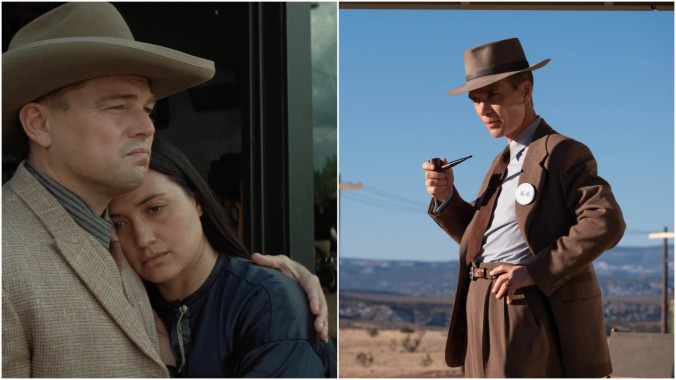Oppenheimer is squeezing Killers Of The Flower Moon out of awards season
There’s only room for one three-hour-plus historical drama 'round these parts

Oppenheimer is blowing up awards season. After becoming the third biggest movie of the year, Christopher Nolan’s film has dominated the awards circuit since sweeping the Golden Globes. Heading into Academy Award nominations, it’s the frontrunner, but when will Killers Of The Flower Moon get its flowers?
With Oppenheimer in the running, it doesn’t appear there’s space for two three-hour historical bio-dramas about the 20th century’s great American-born atrocities. Despite being a much-discussed and widely praised work by, arguably, the world’s greatest filmmaker, Martin Scorsese’s Killers Of The Flower Moon has faltered on the awards scene. Many, including this writer, consider Killers the better film, but there are practical reasons why Oppenheimer is finding more success aside from voters simply preferring one to the other.
Superficially, there is a lot of overlap between the two films. For one thing, they’re both profound dramas about the ills of the 20th century, made with great care and artistry. However, only one turns the camera back on the audience. Killers Of The Flower Moon leaves audiences in a liminal space, where Martin Scorsese himself takes the stage, points at the audience, and essentially says, “We’re all complicit in this crime against the Native American people and guilty of treating it like entertainment.” Oppenheimer used American boosterism and nationalism as a reason for America killing more than 200,000 civilians in Hiroshima and Nagasaki when World War II was already winding down. But the movie’s final shot places the blame on the scientists and what they wrought. While hardly a crowd pleaser, it’s enough to give the audience an out that Killers doesn’t offer. Audiences took the out.
Oppenheimer became a worldwide phenomenon, thanks, in some part, to a boost from “Barbenheimer.” The meme got butts in seats, but not without caveats. While most entered Barbie ready for a good time, Oppenheimer’s long-term viability wasn’t guaranteed. It is a three-hour movie about physics, after all. Furthermore, Oppenheimer’s complicated release required an industry-wide overhaul, installing massive 70mm IMAX projectors into movie theaters nationwide and retrofitting others with 70mm and 35mm projectors that have long gone out of style thanks to the ease and automation of newer digital ones. The gambit worked. Seeing the film in specific formats wasn’t just a novelty. For some, it was a requirement, with filmgoers crossing state lines and buying tickets on the black market for spots in sold-out screenings. Oppenheimer became about the theatrical experience as a whole. Watching Oppenheimer the way Christopher Nolan intended actually became something people wanted to do. Nolan figured out how to package a reasonably unsexy film into an experience worth leaving the house for, a rare bright spot in a blockbuster landscape bursting with brand synergy.
Killers Of The Flower Moon, by contrast, was never designed to get people back in theaters. It wasn’t even produced for theatrical release. Apple paid for the film to give Apple TV+ subscribers a reason to keep paying $9.99 for a relatively limited library. Killers only ended up in theaters because of the strikes and, likely, Oppenheimer’s success, which showed potential for lengthy dramas. When Dune and Kraven The Hunter jumped from fall 2023 to 2024, it made space for Apple to recoup some of the $200 million it reportedly spent on Killers. The movie wasn’t a runaway success, but on streaming Killers Of The Flower Moon would have made zero dollars as opposed to the $156 million it made worldwide. But Killers’ theatrical release was also tricky. A half-hour longer than Nolan’s film, its three-hour-and-26-minute runtime was a tough sell. Though it did reignite the “movies are too dang long” debate and inspired theaters to insert intermissions into the movie, the runtime overwhelmed the conversation and probably scared some away from the movie.
We’re speculating here, but it’s possible awards voters were also scared off by the film’s runtime, too. They had already sat through a three-hour historical drama that year, and getting them into a second may have been difficult. Moreover, Oppenheimer encouraged multiple viewings—if only to see the differences in format—and was a surprise hit on home media, another shrinking market that Oppenheimer’s popularity revived. 4K discs quickly sold out at a time when retailers were ditching the format. As a result, voters likely watched Oppenheimer with their families over the holidays more significantly than Killers Of The Flower Moon, helping Nolan’s film stay front of mind. Thus far, Lily Gladstone’s performance is the only thing that stood out to voters about Killers. Maybe Killers is lucky Oppenheimer doesn’t have a lead female actor to compete in Best Actress—Gladstone has enough trouble with Emma Stone lumbering around. In a year devoid of another movie where men wear wide-brim hats, Killers Of The Flower Moon might have fared better. But in 2024, Oppenheimer has become death, destroyer of Oscar chances.